
Royal Botanic Gardens, Kew, is a non-departmental public body in the United Kingdom sponsored by the Department for Environment, Food and Rural Affairs. An internationally important botanical research and education institution, it employs 1,100 staff. Its board of trustees is chaired by Dame Amelia Fawcett.
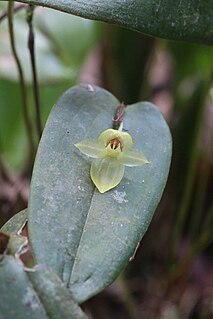
Pleurothallis is a genus of orchids commonly called bonnet orchids. The genus name is derived from the Greek word pleurothallos, meaning "riblike branches". This refers to the rib-like stems of many species. The genus is often abbreviated as "Pths" in horticultural trade.
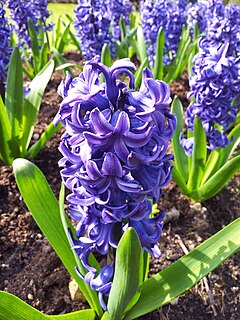
Hyacinthus is a small genus of bulbous, spring-blooming perennials. They are fragrant flowering plants in the family Asparagaceae, subfamily Scilloideae and are commonly called hyacinths. The genus is native to the area of the eastern Mediterranean from the north of Bulgaria through to the northern part of the region of Palestine.

Muscari is a genus of perennial bulbous plants native to Eurasia that produce spikes of dense, most commonly blue, urn-shaped flowers resembling bunches of grapes in the spring. The common name for the genus is grape hyacinth, but they should not be confused with hyacinths. In the United States, they are also commonly referred to as bluebells, though certain regions reserve this name for bluebonnets instead. A number of species of Muscari are used as ornamental garden plants.

Guzmania is a genus of over 120 species of flowering plants in the botanical family Bromeliaceae, subfamily Tillandsioideae. They are mainly stemless, evergreen, epiphytic perennials native to Florida, the West Indies, southern Mexico, Central America, and northern and western South America. They are found at altitudes of up to 3,500 m (11,483 ft) in the Andean rainforests.
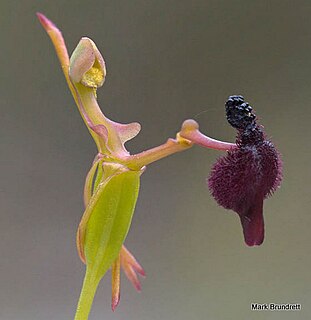
Drakaea is a genus of 10 species in the plant family Orchidaceae commonly known as hammer orchids. All ten species only occur in the south-west of Western Australia. Hammer orchids are characterised by an insectoid labellum that is attached to a narrow, hinged stem, which holds it aloft. The stem can only hinge backwards, where the broadly winged column carries the pollen and stigma. Each species of hammer orchid is pollinated by a specific species of thynnid wasp. Thynnid wasps are unusual in that the female is flightless and mating occurs when the male carries a female away to a source of food. The labellum of the orchid resembles a female thynnid wasp in shape, colour and scent. Insect pollination involving sexual attraction is common in orchids but the interaction between the male thynnid wasp and the hammer orchid is unique in that it involves the insect trying to fly away with a part of the flower.

Aphyllanthes is a genus of flowering plants with only one species, Aphyllanthes monspeliensis, endemic to the western Mediterranean region. It is the only genus in the Aphyllanthoideae, a subfamily of the family Asparagaceae. Aphyllanthoideae was formerly treated as a separate family, Aphyllanthaceae.

Copernicia is a genus of palms native to South America and the Greater Antilles. Of the known species and nothospecies (hybrids), 22 of the 27 are endemic to Cuba. They are fan palms, with the leaves with a bare petiole terminating in a rounded fan of numerous leaflets. The species are small to medium-sized trees growing to 5–30 m tall, typically occurring close to streams and rivers in savanna habitats.
Bactris major is a small to medium-sized spiny palm which ranges from Mexico, through Central America into northern South America and Trinidad. The species is divided into three or four varieties, although the boundaries between varieties is not always clearly defined.
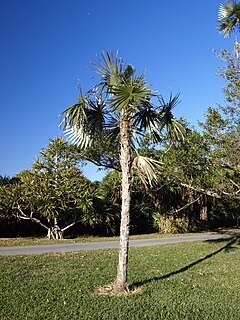
Coccothrinax salvatoris is a palm which is endemic to eastern and east central Cuba.

Chelonistele sulphurea is a species of orchid that grows along the Malay Peninsula, Borneo, Sumatra, Java, and Philippines. The plant blooms small, fragrant flowers.
Dipentodontaceae is a family of flowering plants containing two genera.
- DipentodonDunn - southern China, Assam, Myanmar
- PerrottetiaKunth in F.W.H.von Humboldt - southern China, Southeast Asia, Papuasia, Queensland, Hawaii, Latin America.

Dendrobium bigibbum, commonly known as the Cooktown orchid or mauve butterfly orchid, is an epiphytic or lithophytic orchid in the family Orchidaceae. It has cylindrical pseudobulbs, each with between three and five green or purplish leaves and arching flowering stems with up to twenty, usually lilac-purple flowers. It occurs in tropical North Queensland, Australia and New Guinea.
The World Checklist of Selected Plant Families is an "international collaborative programme that provides the latest peer reviewed and published opinions on the accepted scientific names and synonyms of selected plant families." Maintained by the Royal Botanic Gardens, Kew, it is available online, allowing searches for the names of families, genera and species, as well as the ability to create checklists.
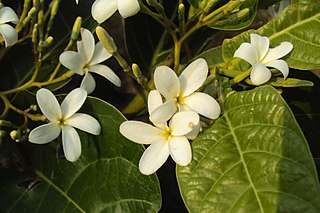
Holarrhena is a genus of plant in the family Apocynaceae first described as a genus in 1810. It is native to tropical and southern Africa as well as south, east, and southeast Asia. As of August 2013 the World Checklist of Selected Plant Families recognises 5 species:
Pycnobotrya is a monotypic genus of plant in the family Apocynaceae found in tropical Africa. As of August 2013 the World Checklist of Selected Plant Families recognises the single species Pycnobotrya nitida.

Schrebera is a genus of plant in the family Oleaceae found in Peru, tropical and southern Africa, India and Southeast Asia. As of September 2013 the World Checklist of Selected Plant Families recognises 8 species:

Diurideae is a tribe of orchid in the subfamily Orchidoideae. It contains about 40 accepted genera. As of April 2018, its division into subtribes remained unclear.

Eastern Asia is one of the regions of temperate Asia defined in the World Geographical Scheme for Recording Plant Distributions (WGSRPD) for use in recording the distribution of plants. It is very much smaller than common definitions of East Asia. It consists of the Korean Peninsula, Japan, and Taiwan. Some islands belonging to Japan politically, such as Marcus Island (Minami-Tori-shima), have greater floristic affinity with similar Pacific islands and are placed in the botanical continent of the Pacific.
Plants of the World Online is an online database published by the Royal Botanic Gardens, Kew. It was launched in March 2017 with the ultimate aim being "to enable users to access information on all the world's known seed-bearing plants by 2020". The initial focus was on tropical African Floras, particularly Flora Zambesiaca, Flora of West Tropical Africa and Flora of Tropical East Africa.















